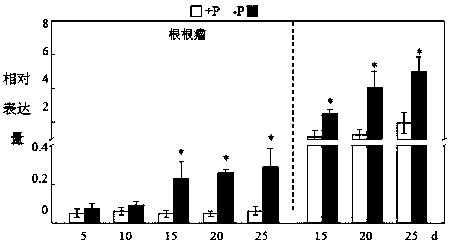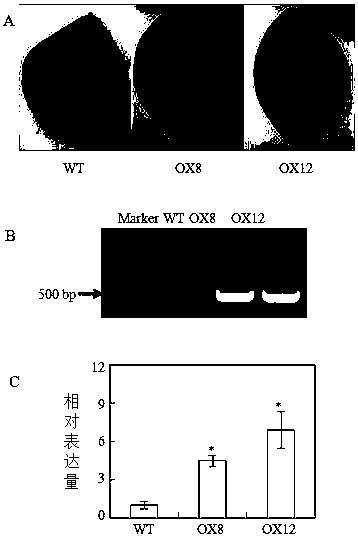Gene GmSPX5 for regulating and controlling growth of leguminosae root nodules, and application of gene GmSPX5
A gene and root nodule technology is applied to the gene GmSPX5 that regulates the growth of leguminous root nodules and its application fields, which can solve the problems of few reports, few studies, and no gene function.
- Summary
- Abstract
- Description
- Claims
- Application Information
AI Technical Summary
Problems solved by technology
Method used
Image
Examples
Embodiment 1
[0051] Example 1 GmSPX5 Gene cloning and vector construction
[0052] 1. Excess (OX -GmSPX5- pTF) expression vector construction
[0053] (1) design GmSPX5 Gene-specific primer OX- GmSPX5 -pTF-F and OX- GmSPX5 -pTF-R:
[0054] Primer OX- GmSPX5 -pTF-F (SEQ ID NO. 3):
[0055] 5'-GCTCTAGAATGAAGTTTGAGAAGATCCTGAAG-3'
[0056] Primer OX- GmSPX5 -pTF-R (SEQ ID NO.4):
[0057] 5'-TCCCCCGGGCTAGTTGTGTGGAGAAGATGGG-3'.
[0058] (2) PCR amplification: using soybean genotype YC03-3 phosphorous deficiency treated root nodule cDNA as a template, using gene-specific primers OX- GmSPX5 -pTF-F (SEQ ID NO.3) and primer OX- GmSPX5 - pTF-R (SEQ ID NO.4) was amplified GmSPX5 Coding region fragment. The PCR reaction system is 50 microliters, including 5 microliters of 10×Ex Taq Buffer, 4 microliters of 2.5 mmol / L dNTP, 3 microliters of cDNA template, and 1 microliter of 10 micromol / liter forward and reverse primers. liters, 0.5 microliters of ExTaq enzyme, and finally make up to 50 ...
Embodiment 2
[0068] Example 2 GmSPX5 Analysis of gene expression patterns and protein subcellular localization
[0069] 1, GmSPX5 Gene expression pattern analysis
[0070] (1) Experimental method
[0071] Experimental design: Set up two phosphorus concentration treatments, high phosphorus (+P) is 250 micromol / L KH 2 PO 4 , phosphorus (-P) deficiency of 5 μmol / L KH 2 PO 4 ; Nitrogen level is 500 micromole / L of total nitrogen; The cultivation device is a 15-liter blue light-proof bread box, which is cultivated in a solar greenhouse, and each treatment is set to replicate four times.
[0072] Seedlings: use roll paper for seedlings. Pick seeds of the same size and dry them with chlorine gas (100 ml of sodium hypochlorite + 4.2 ml of hydrochloric acid) for 12 hours, then place them side by side on one side of the wet seedling paper with an interval of about 1 cm, roll up the seedling paper, and fix the seeds One end of the plant is facing up (the hilum is facing down), put it verticall...
Embodiment 3
[0088] Example 3 Research on transgenic materials
[0089] 1. Obtaining genetically modified materials
[0090] Agrobacterium tumefaciens mediated whole plant transformation of cotyledon nodes. The main steps include:
[0091] (1) Seed germination. Select soybean seeds with undamaged seed coats for surface disinfection in chlorine for 12-14 hours, then place the seeds in an ultra-clean workbench for 30 minutes to remove excess chlorine; Cultured for 4 days.
[0092] (2) Preparation of bacterial solution. Overexpress the constructed OX -GmSPX5- The pTF vector plasmid was transformed into Agrobacterium tumefaciens EHA101 by freeze-thaw method, and the positive clones were picked and inoculated in YEP culture medium containing corresponding resistance, cultured at 28°C and 200 rpm until the OD650 was 1.0, and then the colonies were collected by centrifugation and used Suspend the bacteria in CM liquid until the OD650 is 1.0.
[0093](3) Cotyledon node infection and co-cul...
PUM
 Login to View More
Login to View More Abstract
Description
Claims
Application Information
 Login to View More
Login to View More - R&D
- Intellectual Property
- Life Sciences
- Materials
- Tech Scout
- Unparalleled Data Quality
- Higher Quality Content
- 60% Fewer Hallucinations
Browse by: Latest US Patents, China's latest patents, Technical Efficacy Thesaurus, Application Domain, Technology Topic, Popular Technical Reports.
© 2025 PatSnap. All rights reserved.Legal|Privacy policy|Modern Slavery Act Transparency Statement|Sitemap|About US| Contact US: help@patsnap.com



